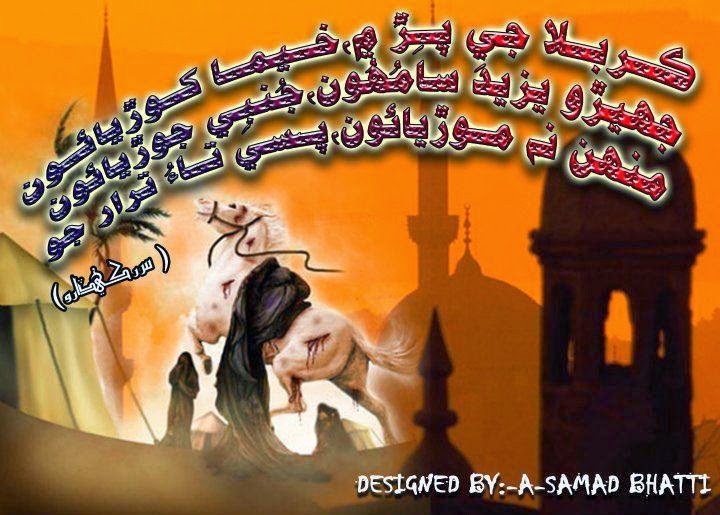
The major thinker behind Sindhi nationalism, G. M. Sayed, whose work gave theoretical grounding to a vision of Sindh as a ‘repository’ of mysticism, in fact first expressed this idea in the 1940s
By Julien Levesque
When ‘the land of Shah Latif bleeds again’, ‘can Sufism save Sindh?’ – Thus asked an opinion article following a recent attack on a Shia imāmbārgāh in the northern Sindhi town of Shikarpur which left more than 60 people dead. For this commentator as for many in Pakistan, Sindh had so far been relatively spared by communal and sectarian violence thanks to its ‘Sufi ethos [which] has long been cherished as the panacea for burgeoning extremism in Pakistan’. Except for a few cases of communal violence in the years leading up to partition, and a few cases of sectarian violence such as the massacre of 116 Shias during a Muharram procession in Therhi in June 1963, Sindh is generally thought of as a province where various religious communities coexist peacefully. But the omissions in this overly simple portrayal – such as the ethnic and sectarian violence in Sindh’s urban centers – in fact reveal the extent to which a certain reified conception of Sindh’s culture – rural, peaceful, and traditional – is associated with a certain form of Muslim religiosity or Sufism, understood as a quietist search for divine union.
The depiction of Sindh as a ‘land of Sufis’ has become a cliché repeated ad nauseam by Sindhis themselves as well as by non-Sindhis, including Karachi’s Muhajirs.
Political leaders and activists have no scruples referring to it, whether it is common nationalist workers who, during my fieldwork, wanted to impress upon me that they, Sindhis, are ‘Sufi by nature’, or the former Sindh Culture minister, Sassui Palijo, when she declared in January 2011, that ‘Sindh has remained relatively calm and peaceful for decades because of the overwhelming influence of Sufi teachings spread by great Sufi saints and poets’.
With such statements, people reiterate a long discursive tradition that can be traced to colonial writings on Sindh around the time of its conquest by the British in 1843.
Anthropologist Oskar Verkaaik has coined a term, ‘the ethnicization of Islam’, to describe the articulation, in Pakistan, of ethnic identities with certain approaches or practices of Islam. He argues that ‘Islam has become [over time] the main language with which ethnicity is produced [in Pakistan]. Islam is now the single-most important boundary-marker between various ethnic categories’. One aspect of Verkaaik’s argument is that since identity affiliations in Pakistan all revolve around Islam in one way or another, Pakistan’s nation building process has been successful in placing Islam at the center of political debates on ethnicity. Another aspect of his argument highlights the association of certain approaches to Islam with certain ethnic groups, as the title of his article suggests by mentioning ‘Sindhi Sufis’, ‘Muhajir Modernists’ and ‘Tribal Islamists’. When it comes to Sindh, Verkaaik writes that ‘a separate Sindhi tradition of Islam was formulated and defended on the basis of refashioned, local, mystical traditions’. This ‘ethnicization of Sufism’ consists of the conscious reference to Sufism as a characteristic or as an essential trait of Sindhi identity, as illustrated by Sassui Palijo’s public statement, the previously quoted opinion article or the assertion made to me by nationalist activists. Claiming one’s religiosity of being Sufi has become a way, in certain social contexts, of asserting one’s Sindhi identity. Hence, the discourse of ‘ethnicized Sufism’ in Sindh has played, like any identity discourse, a performative role in reshaping social boundaries.
But far from happening without contestation, this process in fact places Sufism at the heart of the ‘struggle over representations’, in which various social groups, each with its own particular position in the relations of power within a given social field, vie for imposing their own ‘di-vision of the social world’. The Sindhi identity discourse on Sufism, shaped in large part by the nationalist leader G. M. Sayed, is itself pinned against Pakistan’s official nationalism, which initially sought to promote the Urdu language and Islam as unifiers so as to transform Pakistan’s social, cultural and religious diversity into a single nation made of abstract citizens. Yet the fluctuations in the positioning of the state towards cultural and religious diversity—from Ayub Khan’s nationalization of shrines to Zulfiqar Ali Bhutto’s accommodation of religious diversity to Zia ul-Haq’s Islamization policy— also structured the definition of Sindhi identity by determining what is subversive (‘anti-Pakistan’) and what is acceptable. The idea of Sindh’s identity being grounded in Sufism, in spite of the common usage it has gained, is also hotly contested by some representatives of Sufism in Sindh.
This chapter thus questions the place of Sufism in Sindhi identity construction in independent Pakistan. The first part examines the construction and diffusion of the now dominant Sindhi identity discourse in which being Sufi is presented as an essential trait of being Sindhi, from its colonial roots and to its formalization by G. M. Sayed. The second part of the paper turns to the ‘contested nature of Sufism’, or Sufism at the heart of the ‘struggle over representations’ in Sindh.
 Sindh as a ‘land of Sufis’: the diffusion of a common identity marker Sindh has long been termed a ‘land of Sufis’. This discursive tradition can be traced back, at least, to colonial writings of the second half of the nineteenth century. In 1851, Richard Burton observed: ‘There is nothing more remarkable in Sindh than the number of holy men which it has produced, and the extent to which that modification of Pantheism, called tasawwuf throughout the world of Islam, is spread among the body of the people’. In the following decades, the Sufi poetry of Shah Abdul Latif Bhitai served as learning material for Sindhi for British officials to be posted in Sindh, while the figure of Shah Latif increasingly came to symbolize the religious specificities of Sindh. In the first half of the twentieth century, Sindhi Hindu scholars, often influenced by the Theosophical Society – such as Jethmal Parsram, author of a 1924 book named Sind and Its Sufis – also stressed what they saw as Sindh’s peculiar blend of the philosophy of Advaita Vedanta, or non-duality, and the Islamic conception of wahdat al-wujūd, inspired by the Andalusian philosopher Ibn ‘Arabī. As ‘the land of Sufis and of Saints’ that ‘bears a holy flower [which] will give its fragrance freely to all who seek’ (Gulrajani 1979), Sindh, to these authors, is characterized by an inclusive and tolerant religiosity expressed in the poetry of its Sufi poets, from Qazi Qazan and Abdul Karim Bulri to Sachal Sarmast and, most prominent of all, Shah Abdul Latif Bhitai. This conception allowed for the formulation of an essentialized conception of Sindh’s cultural uniqueness at a time when a new Sindhi Muslim elite was struggling for the constitution of Sindh as a separate province.
Sindh as a ‘land of Sufis’: the diffusion of a common identity marker Sindh has long been termed a ‘land of Sufis’. This discursive tradition can be traced back, at least, to colonial writings of the second half of the nineteenth century. In 1851, Richard Burton observed: ‘There is nothing more remarkable in Sindh than the number of holy men which it has produced, and the extent to which that modification of Pantheism, called tasawwuf throughout the world of Islam, is spread among the body of the people’. In the following decades, the Sufi poetry of Shah Abdul Latif Bhitai served as learning material for Sindhi for British officials to be posted in Sindh, while the figure of Shah Latif increasingly came to symbolize the religious specificities of Sindh. In the first half of the twentieth century, Sindhi Hindu scholars, often influenced by the Theosophical Society – such as Jethmal Parsram, author of a 1924 book named Sind and Its Sufis – also stressed what they saw as Sindh’s peculiar blend of the philosophy of Advaita Vedanta, or non-duality, and the Islamic conception of wahdat al-wujūd, inspired by the Andalusian philosopher Ibn ‘Arabī. As ‘the land of Sufis and of Saints’ that ‘bears a holy flower [which] will give its fragrance freely to all who seek’ (Gulrajani 1979), Sindh, to these authors, is characterized by an inclusive and tolerant religiosity expressed in the poetry of its Sufi poets, from Qazi Qazan and Abdul Karim Bulri to Sachal Sarmast and, most prominent of all, Shah Abdul Latif Bhitai. This conception allowed for the formulation of an essentialized conception of Sindh’s cultural uniqueness at a time when a new Sindhi Muslim elite was struggling for the constitution of Sindh as a separate province.
The idea of Sindh as a place marked by outstanding religious tolerance found its way into the political realm and Sindhi nationalist discourses after Pakistan’s independence. The major thinker behind Sindhi nationalism, G. M. Sayed, whose work gave theoretical grounding to a vision of Sindh as a ‘repository’ of mysticism, in fact first expressed this idea in the 1940s, when the movement in favor of the creation of Pakistan took shape in Sindh. In his draft inauguration speech at the Annual Session of the Muslim League held in Karachi in 1943, G. M. Sayed described Sindh as a ‘center of spiritual knowledge’, thanks to which, in the ‘New World Order’ that would follow World War II, ‘Sind [would] have its own place and a part to play by giving a special message to the world based on the unassailable and ineradicable teachings of Islam which took firmer root here through Savants and Saints of Islam in Sind’ (Sayed 1943).
Hence, by 1943, G. M. Sayed had already formulated what would later become central to his thought, namely, that Sindh’s past as ‘repository’ of mysticism now endows it with a mission to spread peace throughout the world.
The next major step in the crystallization of this idea was the publication in 1952 of a nationalist reinterpretation of Shah Latif’s poetry, which, to him, contains both a description of the essential characteristics of the Sindhi people and an exhortation to collective mobilization (Sayed 1996). But the idea really comes through in one of his later works, G. M. Sayed’s most controversial book, Jīan Ditho Āhe Mūn (literally: how I saw), published in 1967 after a decade of intensive political and cultural self-questioning by Sindhi intellectuals (Sayed 1986). The previous year, G. M. Sayed had established an organization called Bazm-e Sufia-e Sindh (Society [p. 215] of the Sufis of Sindh), which organized conferences and cultural events and also provided a platform to reflect on Sindh’s identity and politics. An outcome of these conferences, the reflections found in Jīan Ditho Āhe Mūn expose G. M. Sayed’s peculiar conception of Sufism. Stating that ‘it is a fact that the Valley of Sindh has always been an island of tolerance for conflicting faiths and cultures’ (Sayed 1986) and that Sindh has ‘a truly generous respect for mankind’, the Sindhi leader then writes that Sindh possesses a ‘message of love’ (Sayed 1986). This book attracted much condemnation for its religious views on Islam but more importantly because asserting, in the context of Pakistan, a Sindhi identity whose essence is found in the Sufi spirit of brotherhood and love for humanity stood against Pakistan’s founding principles, in which the right to a separate state rests on the adherence to Islam.
(Continues)
_________________________
 Julien Levesque holds a Ph.D. (2016) in Political Science from Paris. His doctoral research focused on nationalism and identity construction in Sindh after Pakistan’s independence. Before joining CSH, Delhi he was Adjunct Associate Professor at EHESS in Paris. As a researcher at CSH, Julien Levesque focuses on South Asian Islam and Muslims from the perspective of political sociology. More precisely, his project is to study the social and political role of sayyids, a group generally described as the elite among the elite of Muslims in South Asia.
Julien Levesque holds a Ph.D. (2016) in Political Science from Paris. His doctoral research focused on nationalism and identity construction in Sindh after Pakistan’s independence. Before joining CSH, Delhi he was Adjunct Associate Professor at EHESS in Paris. As a researcher at CSH, Julien Levesque focuses on South Asian Islam and Muslims from the perspective of political sociology. More precisely, his project is to study the social and political role of sayyids, a group generally described as the elite among the elite of Muslims in South Asia.
Courtesy: HAL Archives and CENTER DE SSCIENCES HUMAINES